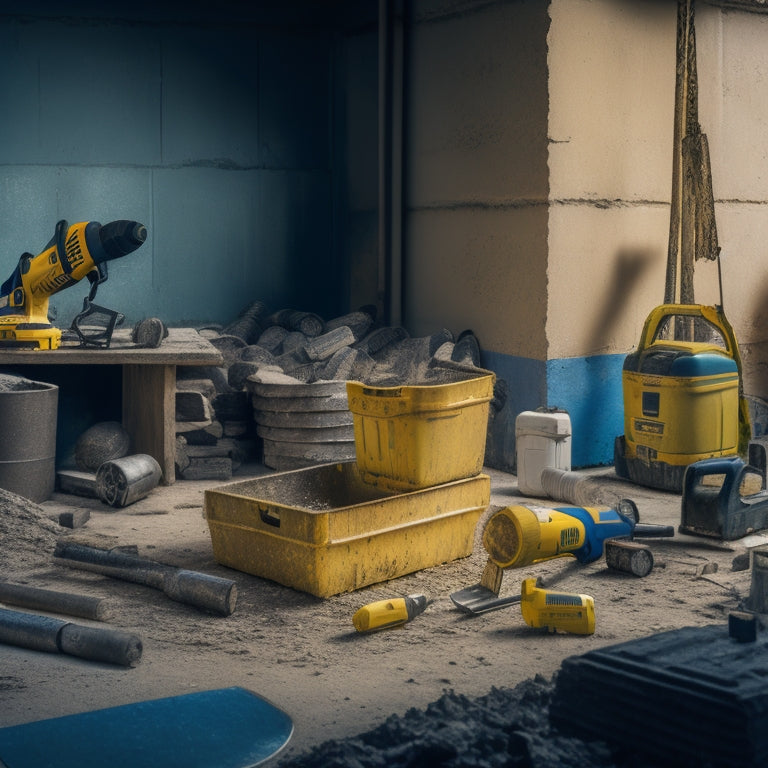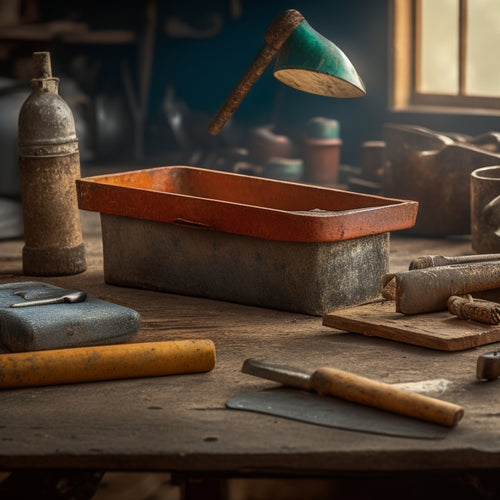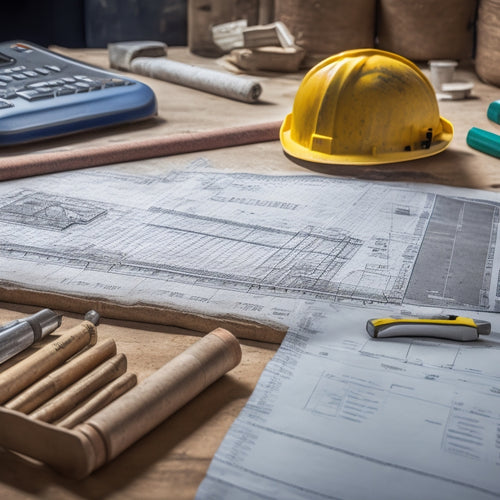
Why You Need These Power Tools for Concrete
Share
You can't afford to tackle a concrete project without the right power tools, as it can mean the difference between a successful outcome and a costly, time-consuming disaster. Wreckers, saws, bits, jackhammers, grinders, and concrete pumps are essential for efficient demolition, precise cutting, and effective drilling, breaking, and smoothing. With the right tools, you'll save time and resources, guarantee safety, and achieve professional-grade results. By understanding how to choose and use these power tools correctly, you'll be well on your way to mastering concrete projects - and that's just the foundation of what you're about to discover.
Key Takeaways
- Efficient concrete demolition and removal with wreckers and saws prevents project stalls and saves time and resources.
- Precise drilling and breaking with the right bits and hammers ensures control, safety, and optimal results.
- Smoothing and finishing with grinders and polishers achieves professional-grade results and distinguishes amateur work.
- Concrete pumps ensure precise mixing and pouring for strong structures, saving time and labor in large projects.
- Mastering power tool techniques and safety precautions reduces hazards, enhances user safety, and achieves high-quality concrete outcomes.
Demolition Made Easy With Wreckers
Many demolition projects stall due to inefficient removal of concrete structures, but with wreckers, you can break through these obstacles.
You'll be able to tackle even the toughest concrete demolition tasks with ease, thanks to the powerful force and precision of these tools. By mastering wrecking techniques, you'll be able to disassemble concrete structures quickly and efficiently, saving you time and resources.
However, it's essential to remember that safety precautions are paramount when working with wreckers. You must wear proper protective gear, including hard hats, gloves, and safety glasses, to prevent injury from flying debris or equipment malfunctions.
Additionally, make certain that you're operating the wrecker in a well-ventilated area, away from flammable materials and other hazards. By following these guidelines and honing your wrecking skills, you'll be able to conquer even the most intimidating concrete demolition projects with confidence and precision.
Cutting Through Concrete With Saws
You've mastered the art of demolition with wreckers, but now it's time to tackle concrete with precision. Cutting through concrete requires the right saws and techniques to avoid damaging the material or compromising your safety.
When it comes to saw types, you'll need:
-
Concrete saws: Designed for heavy-duty cutting, these saws can handle thick concrete slabs and walls.
-
Masonry saws: Ideal for smaller projects, masonry saws are perfect for cutting through brick, block, and stone.
-
Tile saws: For more precise cuts, tile saws are designed for cutting through ceramic, porcelain, and natural stone tiles.
Remember to take necessary safety precautions when cutting through concrete, including wearing protective gear like gloves, safety glasses, and a dust mask.
Always follow the manufacturer's instructions and guidelines for the specific saw you're using.
With the right saw and safety measures in place, you'll be able to make precise cuts and achieve professional-looking results.
Drilling Into Concrete With Bits
When concrete needs holes for anchors, pipes, or other installations, drilling into it is an essential step. You'll need the right concrete bit types and drilling techniques to get the job done efficiently and effectively.
Drilling into concrete requires a bit that's specifically designed for the task. There are several types of concrete bits, each suited for specific applications. Here's a breakdown of some common concrete bit types and their uses:
| Bit Type | Application | Drill Speed |
|---|---|---|
| Twist Bit | General-purpose drilling, anchors, and pipes | 500-700 RPM |
| Masonry Bit | Drilling into brick, block, and concrete | 300-500 RPM |
| Core Bit | Drilling large holes for pipes and ductwork | 200-400 RPM |
| Hammer Bit | Drilling into hard, abrasive concrete | 100-300 RPM |
When drilling into concrete, use a slow and steady approach to maintain control and avoid damaging the bit or surrounding concrete. Apply gentle to moderate pressure, depending on the bit type and concrete density. Keep the bit cool by pausing to clear debris and applying lubricant as needed. With the right bit and technique, you'll be able to drill into concrete like a pro.
Breaking up Concrete With Jackhammers
When breaking up concrete with jackhammers, you'll quickly learn that hammer selection matters - the right tool can make all the difference in efficiency and safety.
You'll want to choose a hammer that's suited to the job's demands, whether that's a lightweight model for tight spaces or a heavy-duty beast for massive slabs.
Hammer Selection Matters
What sets professionals apart from DIYers when breaking up concrete with jackhammers isn't just their technique, but their deliberate hammer selection. You might think a hammer is just a hammer, but that's far from the truth. The right hammer can make all the difference in efficiency, safety, and results.
When choosing a jackhammer, consider the following:
-
Hammer type: Electric, pneumatic, or hydraulic? Each has its strengths and weaknesses. Electric hammers are great for smaller projects, while pneumatic and hydraulic hammers pack more power for larger jobs.
-
Hammer weight: A heavier hammer doesn't always mean more power. Consider a hammer that's balanced and ergonomic to reduce fatigue.
-
Hammer safety features: Look for hammers with safety features like vibration reduction, anti-slip grips, and safety switches to prevent accidental start-ups.
Efficient Demolition Techniques
Break into concrete demolition like a pro by mastering the right techniques for breaking up concrete with jackhammers. You'll get the job done faster, safer, and with less fatigue.
First, prioritize safety precautions: wear protective gear, including gloves, safety glasses, and a dust mask. Verify the area is clear of debris and tripping hazards.
Next, maintain your tool to optimize performance. Regularly inspect and clean the jackhammer, paying attention to the chisel and air hose. A well-maintained tool reduces the risk of breakdowns and accidents.
When breaking up concrete, use a controlled, rhythmic motion to make steady progress. Apply consistent pressure, but avoid overexertion. Keep the jackhammer at a 45-degree angle to maximize impact.
For larger areas, work in sections, breaking up the concrete into manageable chunks. Remove debris as you go to maintain visibility and prevent slipping hazards.
With the right techniques and a well-maintained tool, you'll be able to tackle even the toughest concrete demolition jobs with confidence and precision.
Smoothing Out Concrete With Grinders
You're about to tackle one of the most critical steps in concrete work: smoothing out the surface. This is where the quality of your concrete finishing truly shines.
To achieve a professional-grade finish, you need the right power tools for the job.
Here are the essentials you'll need to get it right:
-
Angle grinders: For aggressive grinding and removal of old adhesives or coatings.
-
Concrete floor grinders: For heavy-duty surface preparation, including removing imperfections and old finishes.
-
Polishing grinders: For the final stages of concrete finishing, where a high-gloss finish is required.
Proper surface preparation is key to a successful concrete finishing project.
With the right grinder, you can guarantee a smooth, even surface that's ready for finishing.
Don't skimp on this step – it's where the difference between amateur and pro is made.
Mixing and Pouring With Concrete Pumps
Precision is key when it comes to mixing and pouring concrete, and that's where concrete pumps come into play. You need to guarantee that the concrete is mixed and poured with accuracy and speed to achieve the desired results.
Concrete pumps offer concrete pump advantages that make them an essential tool for any concrete project.
With a concrete pump, you can achieve efficient mixing and pouring, resulting in a strong and durable concrete structure. These pumps can handle large volumes of concrete, making them ideal for big projects.
You'll be able to pump concrete to hard-to-reach areas, such as upper floors or areas with limited access, with ease. This saves you time and labor, as you won't need to manually transport the concrete.
Additionally, concrete pumps reduce the risk of segregation, which can occur when concrete is transported manually. By using a concrete pump, you'll get a smooth, consistent finish that meets your high standards.
Frequently Asked Questions
What Safety Gear Is Essential When Working With Power Tools on Concrete?
When working with power tools on concrete, you need essential safety gear like safety goggles to protect your eyes from debris and hearing protection to prevent permanent damage from loud machinery.
Can I Use Power Tools on Freshly Poured or Still-Curing Concrete?
You can't use power tools on freshly poured or still-curing concrete - it's a recipe for disaster. Fresh concrete considerations demand patience, as the curing process impact can be devastating, causing irreparable damage to the concrete and your tools.
How Often Should I Maintain and Clean My Power Tools for Concrete?
You should maintain and clean your power tools for concrete regularly to guarantee tool longevity, ideally after every use or at least weekly, to prevent damage and extend their lifespan, saving you time and money in the long run.
Are Power Tools for Concrete Suitable for DIY Projects or Only Professionals?
You're like a master chef, wielding power tools for concrete like precision knives, and wondering if they're only for pros or DIY-friendly too; the answer is, both - with the right training and safety precautions, you can tackle small to medium-sized DIY projects with ease.
Can I Rent Power Tools for Concrete Instead of Buying Them Outright?
You can definitely rent power tools for concrete, but weigh the cost comparison first. Rental options vary, so factor in frequency of use and project scope to determine if buying outright is more cost-effective for you.
Conclusion
You've got the scoop on the top power tools for tackling concrete projects. Now, it's time to get down to business. With wreckers, saws, bits, jackhammers, and grinders in your arsenal, you'll be crushing concrete like a pro. And when it comes to mixing and pouring, concrete pumps will be your new best friend. Remember, the right tools make all the difference between a DIY disaster and a concrete masterpiece. So, gear up and get ready to take your concrete skills to the next level!
Related Posts
-

Smart Guide to Buying Used Concrete Hand Tools
You're about to buy used concrete hand tools, and you need to get it right. Dedicate time to identify the tools you n...
-

Essential Tools for Concrete Wall Covering Projects
When tackling a concrete wall covering project, you'll need a range of essential tools and equipment. For cleaning an...
-

5 Tips for Accurate Concrete Measurement Tools
To guarantee accurate concrete measurement, you'll want to calibrate your measuring tools regularly, choosing a frequ...


